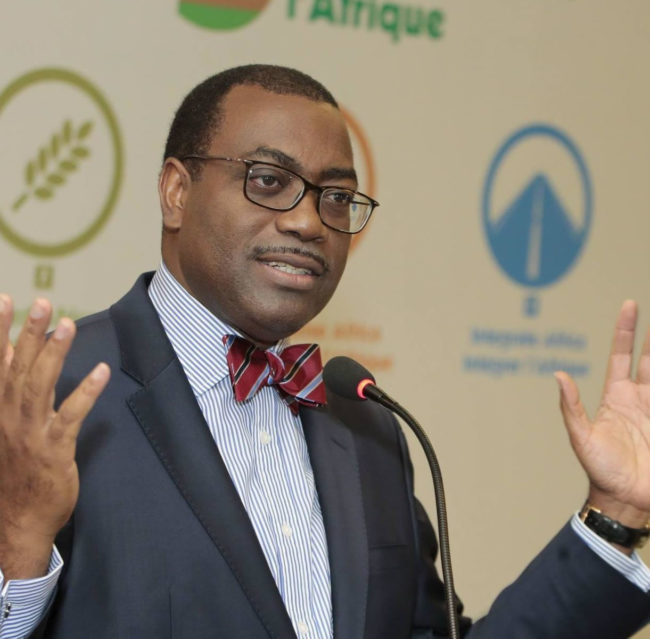The African Development Bank (AfDB), the premier financier of infrastructure in Africa, has committed more than $44 billion to infrastructure across the continent in the last six years.
The funding covers such critical areas as transport, energy, water, and sanitation, but “despite the collective efforts, Africa is still faced with an infrastructure financing gap of $68 to $108 billion annually”.
This was disclosed by the African Development Bank Group President Akinwumi Adesina at the high-level virtual roundtable event to discuss scaling up of infrastructure financing, organised in the context of President Biden’s Building Back a Better World plan, which was moderated by US Assistant Secretary for International Trade and Development Alexia Latortue.
Speaking at the virtual roundtable, Adesina laid out steps for a collective global path on infrastructure financing and commended Secretary Yellen and the Biden Administration for mobilising development resources to expand infrastructure financing, which he said was critical for Africa and other parts of the developing world.
Adesina proposed eight solutions to bridge Africa’s infrastructure finance gap through “Project preparation, mobilising institutional investors, improving public financing for infrastructure, attracting the private sector, mobilising financing for green infrastructure, dealing with risk, stretching the balance sheet of multilateral development banks, and local currency for infrastructure financing”.
Project preparation facilities, Adesina said are critical to developing bankable infrastructure projects, given that one of the major challenges in infrastructure projects was moving commercially viable projects to financial close.
According to him, the NEPAD Infrastructure Project Preparation Facility, the special fund established to promote regional integration and support African countries in preparing quality, bankable projects to attract investments from both the public and private sector, had so far catalysed $25 billion dollars in downstream investments for integrating infrastructure.
Adesina explained that mobilising institutional investors, including pension funds, sovereign wealth funds and insurance companies held enough resources to scale up infrastructure financing from billions to trillions of dollars.
He said collectively, these institutions, with commercial banks, held $103 trillion of assets under management, adding that “This pool of capital is so vast that what is needed is only 0.03% or up to 0.04% to bridge the infrastructure financing gap for Africa.”
He called on the multilateral development banks to “take early-stage investment risks in the project development phase.”
Improving public financing for infrastructure, Adesina said governments provided the largest share of infrastructure financing and must improve the efficiency of public financing for infrastructure.
He stressed that “they must promote a competitive procurement process, quality project design, timely execution and a better maintenance culture, adding that focus should be on quality infrastructure and go beyond least-cost projects to larger projects that could deliver at scale.
In attracting the private sector, the Bank chief called for governments to focus more on attracting the private sector to infrastructure financing.
He said governments must improve the policy, legal and regulatory environment to support public-private partnership (PPP) investments in infrastructure, pointing out that the African Development Bank Group’s board had just approved a new PPP framework for financing infrastructure.
Adesina asserted that the mobilisation of financing for green infrastructure is critical, with Africa’s share of global green bonds standing at only 0.4 per cent.
He explained that of $522 billion in green bonds issued globally between 2007 and 2018, only $2 billion were issued in Africa, noting that this is why the African Development Bank had collaborated with partners to launch the Alliance for Green Infrastructure in Africa.
The Bank boss said the Just Energy Transition Facility that Africa is developing with G7 partners and South Africa will be an opportunity to raise additional climate finance for the continent.
On Dealing with risk, Adesina said the risk was a critical constraint for investment in infrastructure and advised doing more in de-risking through partial risk, and partial credit guarantees to attract the private sector.
Speaking on stretching the balance sheet of multilateral development banks, the African Development Bank chief emphasised the need for multilateral development banks to stretch their balance sheets to finance infrastructure.
He explained that the “African Development Bank had launched a one-billion-dollar synthetic securitization to transfer risk on its private sector portfolio to the private sector”.
On using local currency for infrastructure financing, Adesina explained that because foreign loans finance the bulk of infrastructure, and the revenue streams are in local currency, this presents a high financial risk to investors.
He said more can and should be achieved by focusing on local currency financing for infrastructure. This, he said, could help with debt sustainability, as the bulk of Africa’s debt today was due to infrastructure financing.
Secretary Yellen told the group that even in the face of crises that demand urgent attention, it was important not to lose focus on long-standing issues like infrastructure.
She said a long-term commitment to infrastructure investment is one of the most reliable tools available to increase growth, which would in turn reduce poverty and foster a more stable global economy.
IN CASE YOU MISSED THESE FROM NIGERIAN TRIBUNE
- ‘Officials initially offered to help but when the number of able-bodied citizens at the centre increased, they left us unattended to’
- Why Ogun Tops List Of ‘Yahoo Boys’ In Nigeria ― Governor Abiodun
- Police, Amotekun after criminals on Lagos-Ibadan expressway
- Suspected cannibal pays N500,000 for boy’s human organs, says ‘that’s my favourite meal, especially the throat’
- Court awards Nnamdi Kanu N1 billion over invasion of his home by military, asks FG to apologise
WATCH TOP VIDEOS FROM NIGERIAN TRIBUNE TV
- Let’s Talk About SELF-AWARENESS
- Is Your Confidence Mistaken for Pride? Let’s talk about it
- Is Etiquette About Perfection…Or Just Not Being Rude?
- Top Psychologist Reveal 3 Signs You’re Struggling With Imposter Syndrome
- Do You Pick Up Work-Related Calls at Midnight or Never? Let’s Talk About Boundaries






